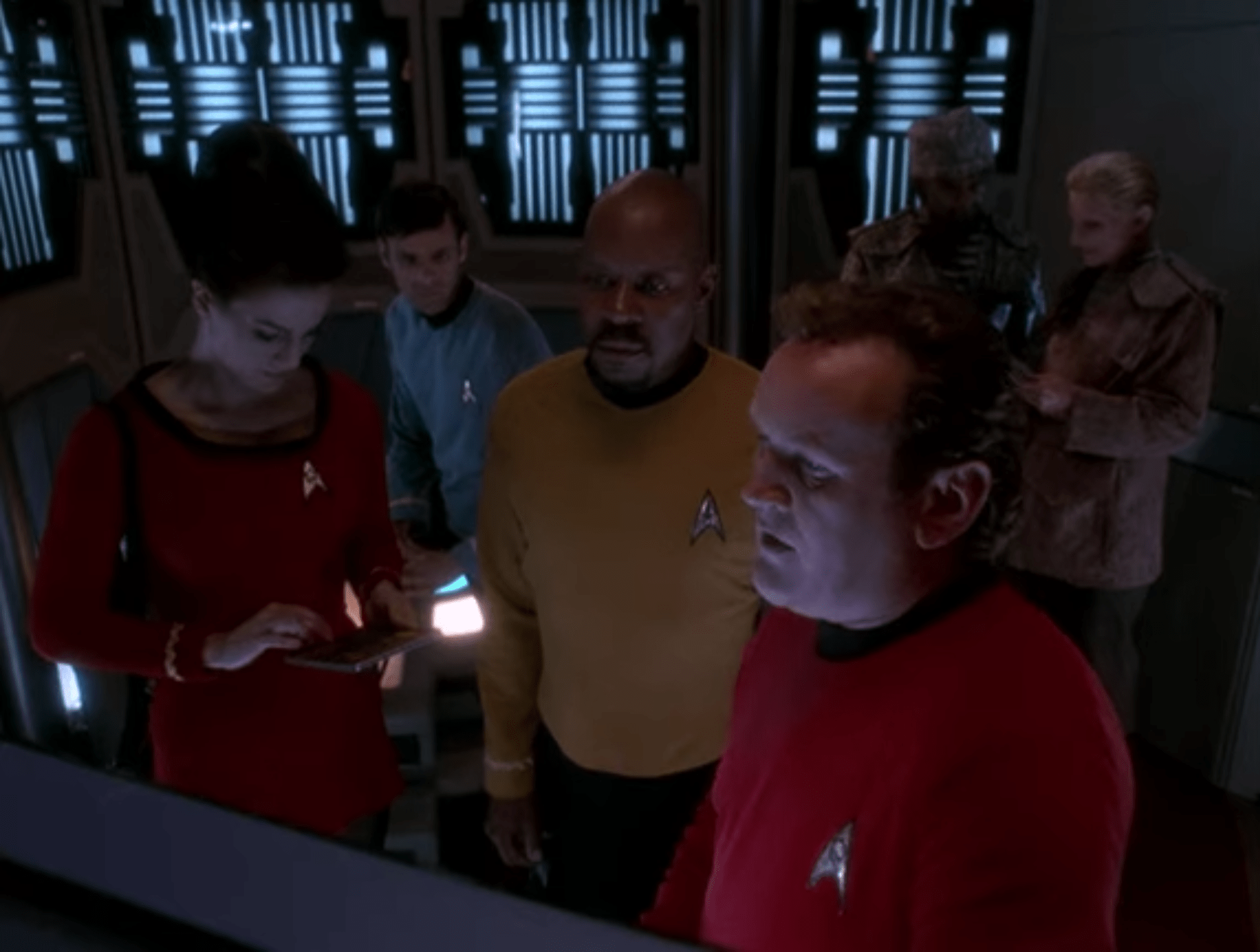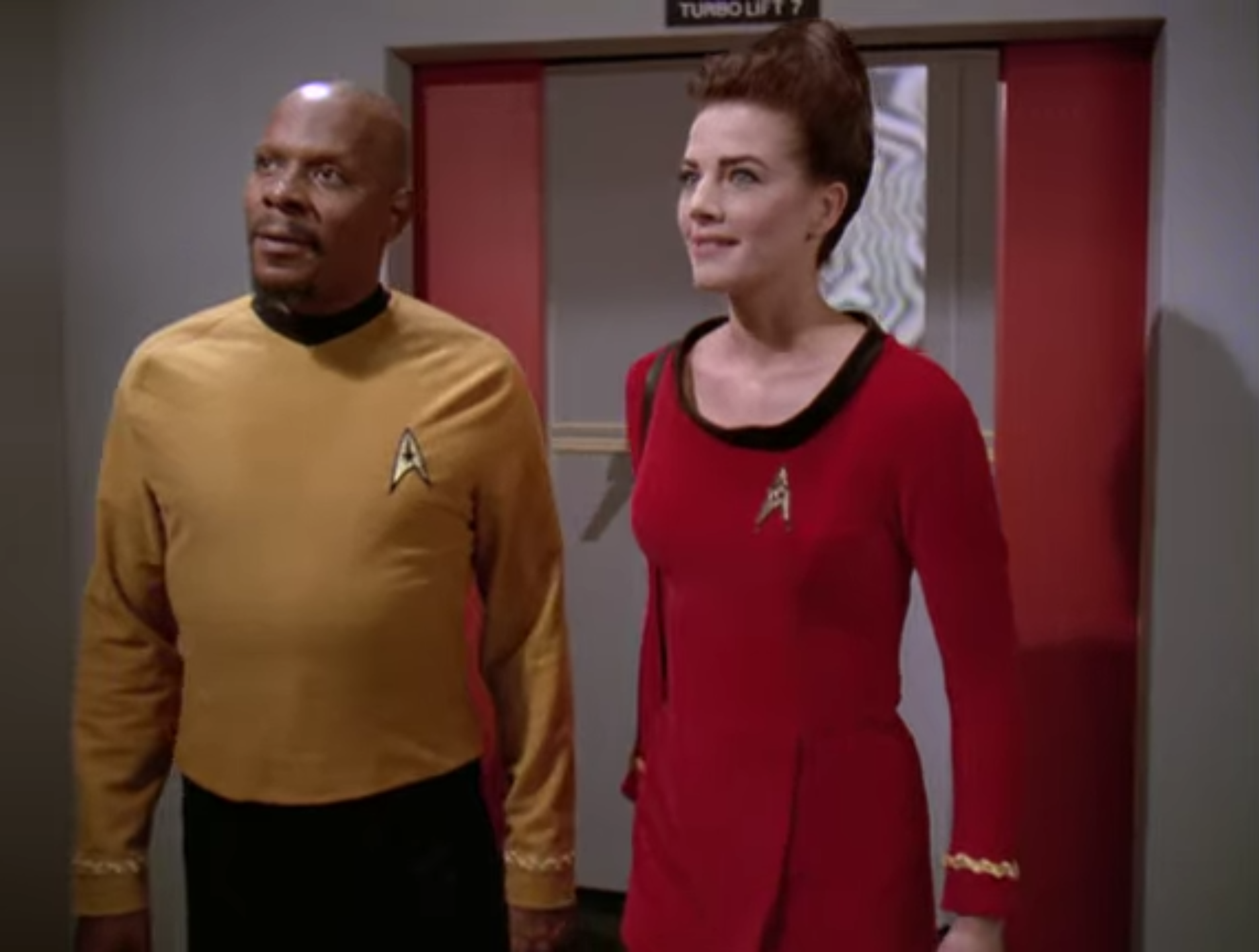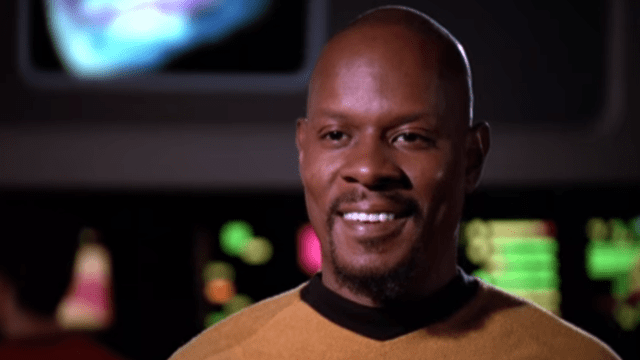We laud Deep Space Nine as the “dark” Star Trek show. Crises of religion and revolution, tales of the Federation’s recalcitrance and glaring imperfections, a story of war in the heart of utopia. Even its brightest lights could reflect the darkest griefs and struggles of its heroes. But 25 years ago today, Deep Space Nine took a look back at the history it so often interrogated with a lovingly nostalgic lens, if only for a little while.
Nestled into the early episodes of Deep Space Nine’s fifth season, Star Trek’s 30th anniversary — and Deep Space Nine’s contribution to the celebrations, “Trials and Tribble-ations” — comes at something of a turning point for the show at large. On the precipice of cementing that “dark chapter” reputation with the lingering shadow of the impending Dominion War, which would truly kick off at the season’s climax, DS9 season five gives us conflicts on two fronts that represent differing external and internal rots within the Federation that the Dominion conflict would crack right open. In episodes like “Apocalypse Rising” and “…Nor the Battle to the Strong,” we find the Federation’s relationship with the Klingons — once a sign in early TNG of the great advancements Star Trek’s universe had made coming into the 24th century — at a low not seen since the open hostility between the species and Starfleet in the original Trek. Likewise, the Maquis subplots in stories like “For the Uniform” and “Blaze of Glory” explore the internal conflict between dissident peoples left behind by the Federation’s lack of care and Sisko’s own ever-roiling sense of pride, a sign of a man pushed to the brink who will be pushed time and time again in the conflicts to come.

Season five isn’t all dark portents, though. There’s silliness like the Klingon romance escapades of “Looking for par’Mach in All the Wrong Places,” classic Ferengi hijinks in stories like “Business as Usual” and “Ferengi Love Songs.” It’s fitting then that “Trials and Tribble-ations” sits within a season that pushed and pulled between the tidings of troubles to come and a perhaps more innocent age for Deep Space Nine itself. Because what “Trials” is, if anything, is a glorious celebration of that innocence before our heroes are plunged into a do-or-die battle to defend what that innocence represents, not just to themselves but to the Federation at large. It’s a loving reminder of what Star Trek once was, and what that means not just to its audience, but to the people who inhabit its world centuries later.
Cast as a flashback recollection as Captain Sisko is interrogated by a haughty pair of Temporal Investigations officers for an act of time travel, “Trials” sees a good chunk of the primary DS9 crew — save for Quark and Kira — thrust back into the events of the original Star Trek episode “The Trouble With Tribbles”. After encountering the still-human-disguised Klingon Arne Darvin (spectacularly, a returning Charlie Brill, who portrayed the younger Klingon spy 30 years prior in “Trouble”) on Cardassia, the crew of the Defiant is caught up in Darvin’s plans to go back aboard Station K-7 centuries ago and undo the mistake of his food-supply poisoning… and change the shape of history forever by assassinating the man who stopped him, Captain James T. Kirk. Using a clever mix of set recreations and CG splicing of contemporary actors into original footage from “Trouble,” “Trials” weaves Sisko, Dax, Bashir, O’Brien, Worf, and Odo effortlessly in and around the events of the original episode — an effect that, two and a half decades later, still holds up perhaps better than most Treks do, its nostalgic haze blurring the line between still-nascent effects techniques. And although there is the somewhat serious thrust of stopping Darvin in the episode (DS9 will earn its shadowed reputation, sure, but it’s not assassinating Captain Kirk for Star Trek’s 30th birthday), what this opportunity provides the series is something rare, and rather wonderful: a chance to reflect on its past in a far more loving light.

And really, it is loving. “Trials” sees Deep Space Nine at a level of gleefully nerdy fanservice that’s rare for Trek even at its most navel-gazing. There’s gags about the colours of command and operations division uniforms swapping between the original series and TNG, and the raunchier side of Starfleet’s formerly mini-skirted female officers. By bringing Worf back to the age of classic Trek, where Klingon appearances were closer to human (and closer to old orientalist tropes), we get an answer as to the actual reason for the difference between the two designs — a guarded reason, played for jokes, nonetheless. It’s almost Rosencrantz & Guildenstern-ian in its farce, as our heroes get caught up the bar brawl from the original episode, or Dax and Sisko find themselves looking for a bomb disguised as a Tribble in the pile of the furry fluffballs that keep comically dropping down onto Kirk. Deep Space Nine had humorous episodes well before “Trials,” but this goes beyond to feel like it knows its audience is in on the joke as well, and revels in that knowledge.
It’s made more poignant in the realisation then, in Deep Space Nine’s wider context, of what our heroes were on the precipice of, and what they were going through in the moment before they were unwittingly whisked off into their own temporal nostalgia. In the present Sisko and his crew are watching the organisation they live for, and its ideals, be tested in a manner unlike anything it has seen for generations, and know that a breaking point is on the horizon. Worf and Odo in particular, our alien outcasts, find themselves pulled between the allegiences they have to their allies in the Federation, and their own peoples. “Trials” gives them all a chance to look back at what once was, how things have changed across a century of Federation history, and to comment, lovingly, on the innocence of a bygone age — when crisis could be subverted with farce, when Starfleet officers were something like spacebound swashbucklers, when the magic of the charisma found in a leader like James Kirk could charm half a galaxy with his reckless, sheer sense of will. While Trek has often had its modern, 24th century (and now in future shows like Discovery, 31st century) characters look upon the age of the original Star Trek with a mirthful sense of how ramshackle and “unproper” Kirk and his crew were, compared to their evolved, enlightened standards, for an hour “Trials” lets Deep Space Nine’s heroes admit that really, they just want to be a bit more like that ramshackle era for a bit.

As “Trials” ends, Sisko recalls how he willingly violated any rules about temporal intervention to go to the Enterprise’s bridge and personally thank Kirk for the chance to serve under him, if only for a short while. He is told by one of his interrogating Temporal Investigators that, hell, if they’d had the chance to say thanks to Jim Kirk, they would’ve done it too. It’s a moment of earned indulgence that these characters crave, as the world around them is beginning to fall apart and become almost unrecognizable. Weaving fannish nostalgia into the actual lives of Deep Space Nine’s characters makes for a loving tribute to what Star Trek once was, and will always strive to be, even as the series goes on to test its limitations: a gleeful calm before the storm.
Wondering where our RSS feed went? You can pick the new up one here.
